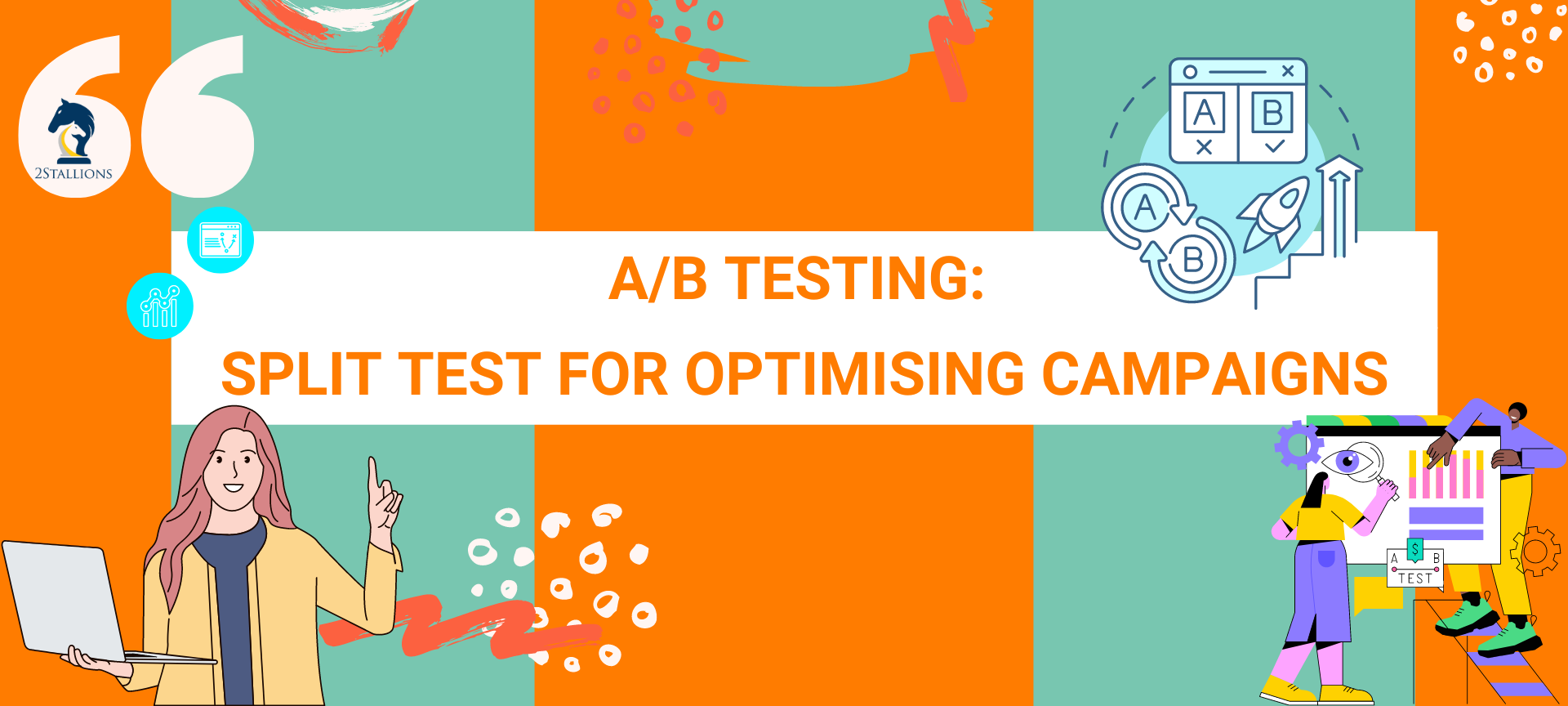Content
SHARE

A/B testing, also known as split testing, is a fundamental concept in digital marketing. This method involves comparing two versions of a webpage or other user experience to determine which one performs better. It is a way to test changes to your webpage against the current design and determine which one produces superior results.
Understanding A/B testing is crucial for marketers as it allows them to make data-driven decisions and move away from guessing or relying on gut feelings. It can help to improve a wide range of elements on a website or in a marketing campaign, from headlines and call-to-action buttons to images and content length.
Concept of A/B Testing
The concept of A/B testing is relatively straightforward. It involves taking a webpage or user experience and modifying it to create a second version of the same page. This change can be as simple as a single headline or button, or it can be a complete redesign of the page. Then, half of your traffic is shown the original version of the page (known as the control) and half is shown the modified version of the page (known as the variant).
The engagement of users with each version is measured and collected in an analytics dashboard that is analysed through a statistical engine. You can then determine whether changing the experience had a positive, negative, or no effect on visitor behaviour.
Control and Variant
The control in an A/B test is the currently used version, while the variant is the new version you want to test. The control provides a benchmark against which the variant’s performance is measured. It’s important to only test one variant against the control to ensure that you can accurately attribute any changes in performance to the variant you’re testing.
For example, if you wanted to test the effectiveness of a new call-to-action button, your control would be the webpage with the current button, and your variant would be the same webpage but with the new button. Half of your traffic would see the control, and the other half would see the variant.
Splitting Traffic
When conducting an A/B test, it’s important to split your traffic evenly between the control and the variant. This is to ensure that you have a large enough sample size to make accurate conclusions about the performance of the variant. If you were to split your traffic unevenly, it could skew the results and lead to inaccurate conclusions.
It’s also important to ensure the traffic you’re splitting is representative of your overall audience. Taking into account factors such as demographics, device usage, and browsing behaviour, if your test audience isn’t representative, it could lead to results that don’t accurately reflect the preferences of your overall audience.
Benefits of A/B Testing
A/B Testing benefits for digital marketers:
- Allows more informed decision-making, whereby marketers can use data to determine which version of a web page or user experience is more effective. This leads to improvements in conversion rates to user engagement.
- A/B testing leads to significant improvements and optimisation in a relatively short amount of time. By testing one change at a time, the impact of the change can be seen and implementation can be decided.
Reducing Risk
One of the key benefits of A/B testing is to reduce risk. When making changes to a web page or user experience, there’s always a risk that the change could have a negative impact. By testing the change first, you can ensure that it has a positive impact before implementing it fully.
For example, if you were considering a complete redesign of your website, you could first test individual elements of the redesign through A/B testing. This would allow you to see the impact of each change and make adjustments as necessary, reducing the risk of a full-scale implementation.
Improving User Experience
A/B testing can also help to improve the user experience by testing different versions of a web page or user experience, to find out what works best for your users. This action enhances user satisfaction along with engagement, resulting in higher conversions and revenue.
For example, through A/B testing users prefer a simpler, more streamlined design. Implementing this change increases the user experience and the likelihood of users completing desired actions, such as making a purchase or signing up for a newsletter.
Implementing A/B Testing
Implementing A/B testing involves several steps. Firstly, you need to identify a goal. This could be anything from increasing conversion rates to improving user engagement. Once you have a goal in mind, you can think about what changes might help you to achieve that goal.
Next, you need to create a variant. This involves making a change to the webpage or user experience that you think will help you to achieve your goal. Once you have a variant, you can start to test it against the control.
Choosing a Testing Tool
Some popular A/B testing tools include Google Optimize, Optimizely, and Visual Website Optimizer. These tools can help you to implement A/B testing by splitting your traffic, collecting data, and analysing the results.
When choosing a tool, it’s important to consider factors such as ease of use, functionality, and cost. You should also consider whether the tool integrates with your existing analytics platform, as this can make it easier to analyse the results of your tests.
Analysing Results
Once you’ve run your A/B test, it’s important to analyse the results. This involves comparing the performance of the control and the variant to see which one was more effective.
Metrics to look into :
- Conversion rates
- Bounce rates
- Duration of the time on page to receive a comprehensive view of each version of the performance.
If the variant was more effective, you might decide to implement it fully. If the control was more effective, you might decide to test a different variant. The key is to use the results of your tests to inform your decision-making and continuously improve your website or user experience.
Common Pitfalls in A/B Testing
While A/B testing can be incredibly beneficial, there are also some common pitfalls that marketers should be aware of. One of these is the risk of false positives. This occurs when a test indicates that a change has a positive impact, when in reality the change does not have a significant effect.
Another common pitfall is not running the test for long enough. It’s important to run your test for a sufficient amount of time to ensure that you have a large enough sample size to make accurate conclusions. If you stop your test too soon, you might not have enough data to draw reliable conclusions.
False Positives
False positives can occur when the results of an A/B test indicate that a change has a positive impact, when in reality the change does not have a significant effect. This can occur due to a number of factors, such as statistical noise or changes in user behaviour that are unrelated to the change being tested.
To reduce the risk of false positives, it’s important to use a statistical significance threshold. This is a level of confidence that the results of your test are not due to chance. A common threshold is 95%, which means that you can be 95% confident that the results of your test are not due to chance.
Insufficient Test Duration
Another common pitfall in A/B testing is not running the test for long enough. If you stop your test too soon, you might not have enough data to draw reliable conclusions. This can lead to inaccurate results and poor decision-making.
To avoid this pitfall, it’s important to run your test for a sufficient amount of time. The exact duration will depend on several factors, such as the amount of traffic your website receives and the size of the change you’re testing. As a general rule, you should aim to run your test for at least two weeks to ensure that you have a large enough sample size.
Conclusion
In conclusion, A/B testing is a powerful tool for digital marketers. It allows for data-driven decision-making, reduces risk, and can lead to significant improvements in a relatively short amount of time. However, it’s important to be aware of common pitfalls and to use best practices to ensure that your tests are accurate and effective.
Use these methods to continuously improve your website or user experience and achieve your marketing goals.
A/B Testing FAQs
What is A/B testing and how does it work?
A/B testing, or split testing, involves comparing two versions of a web page, email, or other marketing asset to determine which one performs better in terms of specific metrics like clicks, conversions, or engagement.
Why is A/B testing important for campaign optimization?
A/B testing is crucial as it allows marketers to make data-driven decisions, reducing guesswork and enhancing the effectiveness of their campaigns by identifying which variations of content resonate best with their audience.
How do you set up an A/B test?
Setting up an A/B test involves defining the goal, selecting the variable to test, creating two versions (A and B), splitting your audience randomly, running the test simultaneously, and then analysing the results to see which version achieved better performance.
What are some common mistakes to avoid in A/B testing?
Common mistakes include testing too many variables at once, which can confuse results, not giving the test enough time to produce significant results, and not using a statistically significant sample size, which can skew the outcomes.












